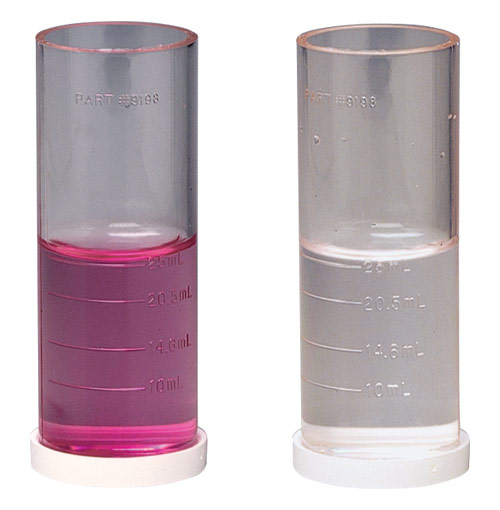FAS-DPD Testing for Accurate Free & Combined Chlorine Values
Since the 1970s, most professionals monitoring water quality in pools and spas have used one of two methods to analyze chlorine levels: OT (orthotolidine), which produces a yellow color in the sample, or DPD (N, N-diethyl-p-phenylenediamine), which produces a pink color. Using OT, one can only measure total chlorine—the sum of active plus spent sanitizer—making it impossible to determine whether an adequate residual exists to disinfect the water. Because of this, health departments in the United States now do not permit the use of OT at regulated facilities.
DPD chemistry can distinguish the active sanitizer, termed free available chlorine. When DPD in either liquid or tablet form is added to a water sample, a pink color forms with an intensity proportional to the chlorine concentration (either free or total, depending on the step you're on in the procedure). The color of the treated sample is then compared to a set of color standards supplied by the test kit manufacturer. These standards may be encapsulated liquid dyes, colored plastic, printed colors on clear film, or printed colors on paper.
Subtracting the free chlorine reading from the total chlorine reading yields the amount of combined chlorine in the water. Combined chlorine, an ineffective sanitizer, causes eye and mucous membrane irritation and the so-called "chlorine odor" associated with poorly maintained pools. Combined chlorine is eliminated by superchlorinating to the breakpoint dosage (aka breakpoint chlorination). Calculations for breakpoint chlorination depend on knowing the amount of combined chlorine in the water, which is why DPD is superior to OT for testing chlorine-sanitized pools.
Most service professionals and a significant number of health officials prefer testing chlorine with FAS-DPD. This variation of the traditional DPD method allows users to measure both free and combined chlorine levels as low as 0.2 ppm—the maximum allowable level for combined chlorine according to most health authorities as well as the Pool & Hot Tub Alliance (PHTA)—and as high as 20 ppm. By contrast, the color comparators used with the standard DPD test generally allow readings at the low end of 0.5 and 1 ppm and at the high end of 5 or maybe 10 ppm.
An FAS-DPD titration is as simple as a test for total alkalinity or calcium hardness. A buffered DPD indicator powder is added to a water sample and reacts with chlorine to produce the pink color characteristic of the standard DPD test. Ferrous ammonium sulfate (FAS) is then added drop by drop until the pink color completely and permanently disappears, signaling the endpoint of the reaction. To get the reading, the number of drops used to cause this color change is multiplied by the appropriate factor for the size of the water sample (supplied by the manufacturer).
The distinct change from a vibrant pink to no color at all eliminates the need for color matching. This means when testing samples with a high level of sanitizer, the user does not have to distinguish between relatively close gradations of color or be concerned that any color has been bleached out of the sample. It is also a boon to the six to eight percent of the population with red-green deficiencies in their color vision (mainly men).
The second part of the FAS-DPD test determines the amount of combined chlorine present (i.e., mono-, di-, or trichloramines) by the number of drops needed to turn the sample from vibrant pink to colorless again.
Not everyone who tries it makes a complete switchover. The cost per test is a little higher and the procedure takes a bit longer. But almost everyone who tries FAS-DPD keeps it on hand for troubleshooting problem pools or use by the "color challenged."
Taylor offers FAS-DPD in several combination kits and as a stand-alone test:
Pool/Spa Test Kits with FAS-DPD
K-1515-A
K-1515-C
K-1517-A
K-1518
K-2006
K-2006-SALT
K-2006C
K-2006C-SALT
K-2009
K-2106
Industrial Test Kits with FAS-DPD


